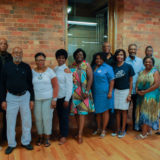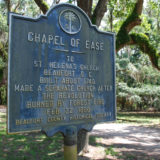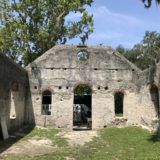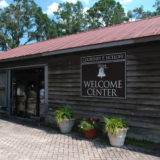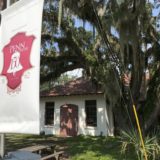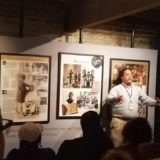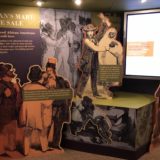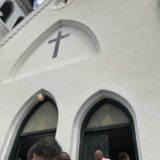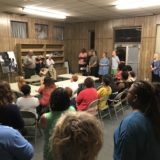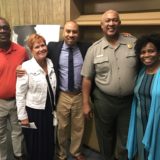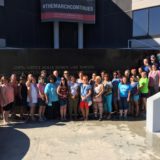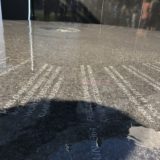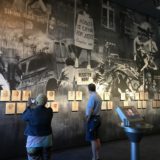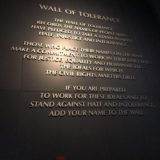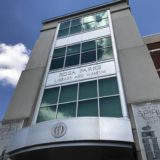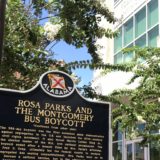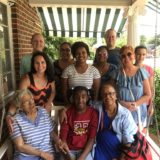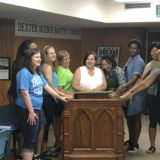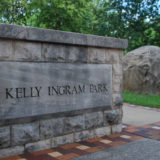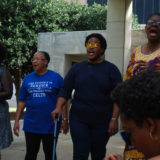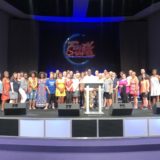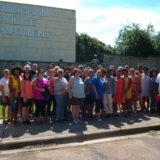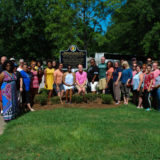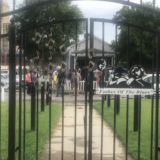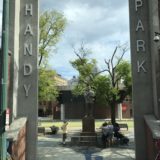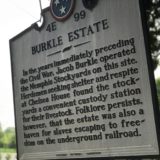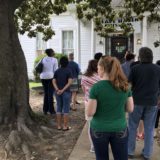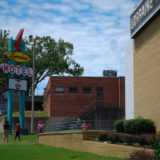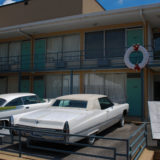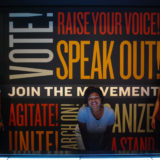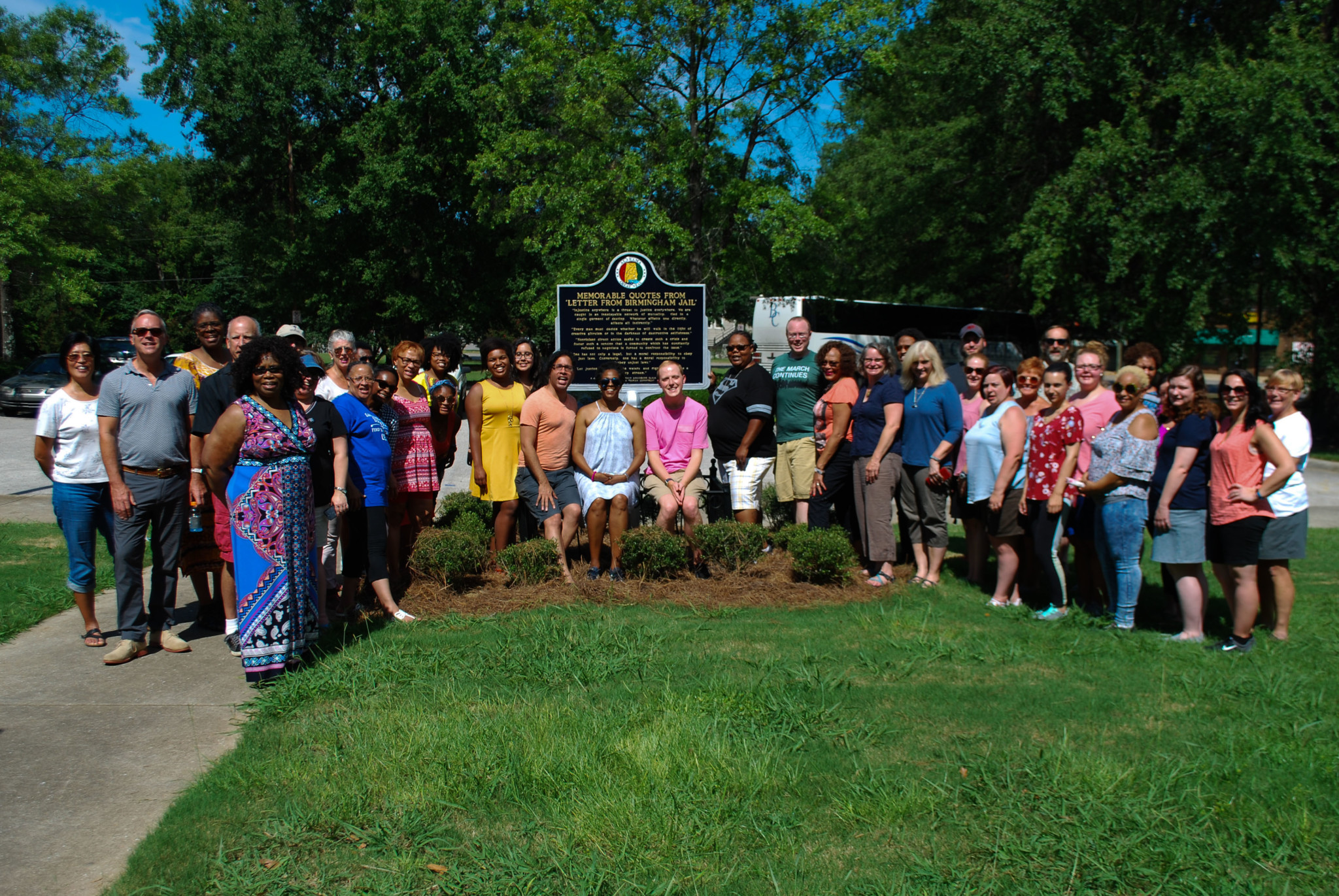
Last week, 40 Berea College faculty and staff members embarked on the biennial Civil Rights Seminar and Tour sponsored by the Carter G. Woodson Center for Interracial Education. The tour visited many locations significant to the American Civil Rights movement of the 1960s. It also presented opportunities for faculty and staff to discuss a variety of topics related to race in America that are still relevant today. The idea of viewing race relations through the lens of a reparations paradigm versus a reconciliation paradigm was a consistent theme in these discussions throughout the trip.
Special thanks to Dr. Kathy Bullock for including songs heard during and inspired by the journey.
Day 1
Laurel Co. African American Heritage Center—London, KY
The first stop on the Civil Rights Tour was the African American Heritage Center, located in London, KY. There, attendees were introduced to Director Wayne Riley, a 2016 Berea College Service Award winner. The current mission of the Center is to aid in remodeling Mill Street Baptist Church, an historic building in London. The Center also serves as a meeting place and public archive for the community.
Learn more about the Laurel County African American Heritage Center here.
Greenville Peace Center—Greenville, SC
After leaving the Heritage Center, the tour group traveled to Greenville, SC to meet a group of Berea College alumni who live in Greenville. The alumni shared their “Berea stories” over a catered, buffet-style dinner. Afterwards, the group was treated to a quick poetry workshop by Glenis Redmond, the poet-in-residence at the Peace Center.
Day 2
“De Gullah Root Experience” —St. Helena Island, SC
Day 2 began with a tour through the Gullah/Geechee Nation by the sovereign nation’s very own Queen Quet. Gullah people are descendants of enslaved Africans who lived in the Low Country regions of Georgia and South Carolina. Queen Quet, who was elected in 1999, took the tour group to a Gullah praise house, the Chapel of Ease, and the public library on the island.
Connect with the Gullah/Geechee Nation on Facebook.
View a photo album from this day on Facebook via the Gullah/Geechee Nation Facebook page.
Penn Center Grounds and Museum—St. Helena Island, SC
The next stop of the day was the Penn Center, formerly known as Penn School, located one mile south of Frogmore, SC. The Center was founded in 1862 by an abolitionist and served as a school for freed slaves. Dr. Martin Luther King Jr. also studied and lectured at Penn Center during his early years as a civil rights leader.
Day 3
Fort Sumter—Charleston, SC
Day 3 began with a boat ride to Fort Sumter, most famous for being the site of the first shots fired in the Civil War. The group received an audio tour while on the boat ride and then toured the fort. Fort Sumter was restored by the U.S. Military after the Civil War and used during the Spanish-American War, World War I, and World War II.
Fort Moultrie—Sullivan’s Island, SC
Sullivan’s Island was the point of entry for approximately 40 percent of the 400,000 enslaved Africans brought to British North America. This made it the largest slave port in North America. Upon arrival, faculty and staff took a guided tour through Fort Moultrie led by a national park service ranger.
The Old Slave Mart—Charleston, SC
The Old Slave Mart once housed an antebellum slave auction gallery where enslaved Africans were sold at public auctions. It is believed that the Old Slave Mart was the last extant slave auction facility in South Carolina. There, the tour group joined an informational session to learn about the economics of the North American slave trade.
Learn more about the Old Slave Mart here.
Music: “Lord How Come Me Here” by Kathleen Battle and Jessie Norman
Mt. Pleasant Public Library—Mt. Pleasant, SC
Following the tour of the Old Slave Mart, the group visited Mt. Pleasant Public Library, where they heard from Prof. Damon Fordham. Fordham explained the history of blacks in South Carolina, specifically the languages, culture and lifestyle of the Gullah people. He explained that the Gullah language should be thought of as a connection between the Africans of America and the Africans of West Africa, not as a sign of illiteracy or “backward English” as it is sometimes viewed.
Day 4
Mother Emmanuel AME Church—Charleston, SC
On Day 4, faculty and staff attended a Sunday morning service at Mother Emanuel African Methodist Episcopal Church. Mother Emanuel is the oldest African Methodist Episcopal church in the South. The church is also noted as being the site of a 2015 shooting, where nine church members were shot and killed by a white supremacist.
Visit Mother Emmanuel AME Church here.
Freedom Riders National Monument—Anniston, AL
Once the tour group arrived in Anniston, AL, they received a warm welcome at the Freedom Riders National Monument. The site is one of three of the newest national monuments, established in January 2017. There, the group learned about the freedom riders, who notoriously traveled in integrated buses to protest Alabama’s Jim Crow laws. City Councilman and Berea alum Seyram Selase ’06 also spoke to the group about his role in establishing the monument.
Day 5
Southern Poverty Law Center—Montgomery, AL
Day 5 began with a tour of the Southern Poverty Law Center (SPLC), which is a nonprofit civil rights organization that stands for justice for the most vulnerable members of society. There, many of the tour attendees pledged and signed their names to the Wall of Tolerance. Over half a million people have taken the pledge to stand against hatred, bigotry, and intolerance.
Rosa Parks Museum—Montgomery, AL
After leaving the SPLC, the group took a guided tour at the Rosa Parks Museum. Rosa Parks is regarded as “the first lady of civil rights.” Parks notoriously refused to give up her seat in the “colored section” of a bus to a white man, defying Alabama’s segregation laws. Although she was not the first person to refuse to give up her seat, NAACP organizers believed Parks was the best candidate to see a court challenge through after her arrest. While Parks’ case ended up bogged down in state courts, Browder v. Gayle succeeded. Browder v. Gayle challenged Montgomery’s segregated public transportation system. As a result of this case, a three-judge panel ruled that the segregation codes violated the Fourteenth Amendment of the U.S. Constitution.
Visit the Rosa Parks Museum at Troy University here.
Music: “Ain’t Gonna Let Nobody Turn Me Around” by Sweet Honey in the Rock
Dexter Avenue Baptist Church Parsonage—Montgomery, AL
After leaving the Rosa Parks Museum, the group met with Dr. Shirley Cherry, who offered an informative and engaging tour of the Dexter Parsonage Museum – Dr. Martin Luther King Jr.’s home in Montgomery, AL. Much of the furniture inside the house was actually used by Dr. King and his family.
Learn more about the Dexter Avenue Baptist Church Parsonage tour here.
Dexter Avenue Baptist Church—Montgomery, AL
After touring Dr. King’s home, the group visited Dexter Avenue Baptist Church, where he was pastor from 1954 to 1959. Dr. King helped organize the Montgomery Bus Boycott in the church’s basement. The group participated in a brief informational session in the sanctuary where Dr. King preached during his time as pastor, and toured the basement. There, the group walked through Dr. King’s office, where family pictures decorated the walls and desk.
Visit Dexter Avenue Baptist Church here.
Day 6
Kelly Ingram Park—Birmingham, AL
The first stop of Day 6 was Kelly Ingram Park in Birmingham, AL. Located across the street from the historic 16th Street Baptist Church, the group took a tour led by Berea alum LaQuita Middleton-Holmes ‘04. The park served as a common ground for large demonstrations during the Civil Rights Movement in the 1960s. In 1963, it was also the location where Birmingham police and firemen turned police dogs and firehoses on demonstrators, many of whom were young children and high school students.
Bus Tour of Birmingham—Birmingham, AL
After the tour of Kelly Ingram Park, the group set off for a bus tour of Birmingham, led by Berea College’s own Carl Thomas ’78, Associate Director of Admissions and Coordinator of Minority Services. During the tour, Thomas also took the group to visit his church, Faith Chapel, located just a few miles from where he grew up.
Birmingham Central Library—Birmingham, AL
Following the bus tour, the group visited the Birmingham Central Library for lunch and an awards presentation. There, Ms. Odessa Woolfolk received her 2017 Berea College Service Award, which was announced earlier this year. The group also heard a presentation from Dr. Gail Bowman, former Director of the Willis D. Weatherford, J. Campus Christian Center at Berea College. Dr. Bowman presented the group with some of her findings from the research work she’s performed in Birmingham since leaving Berea.
16th Street Baptist Church—Birmingham, AL
The final stop of the day was the 16th Street Baptist Church. This church is the site of what Dr. Martin Luther King, Jr. described as “one of the most vicious and tragic crimes ever perpetuated against humanity.” On September 15, 1963, four members of the Ku Klux Klan planted 19 sticks of dynamite outside the basement of the church. The dynamite exploded, killing four young girls—Addie Mae Collins, Carole Robertson, Cynthia Wesley, and Denise McNair—and injuring 22 others. At the church, the group watched a short film about this event and viewed a monument just outside the building near where the dynamite had been planted.
Visit 16th Street Baptist Church here.
Day 7
W.C. Handy House—Memphis, TN
The final day of the Civil Rights Tour began with a heritage tour of Memphis. The WC Handy House Museum was the first stop on this tour. WC Handy, also known as the “Father of the Blues,” was and remains one of America’s most influential songwriters. Handy was influential in bringing blues to a much wider national audience in America. Inside the home, the tour group viewed many artifacts and memorabilia, and listened to some of his iconic music.
Slave Haven (The Burkle Estate)—Memphis, TN
The next stop on Day 7 of the Civil Rights Tour was The Burkle Estate, also known as Slave Haven. Oral history insists that the house was part of the Underground Railroad. The house, now operating as a museum, documents the history of the Underground Railroad and the possible role the house played during that time.
Learn more about Slave Haven Underground Railroad Museum here.
The National Civil Rights Museum—Memphis, TN
The National Civil Rights Museum was the final stop of the Civil Rights Tour. The museum is located in the Lorraine Motel, where Dr. Martin Luther King Jr. was assassinated in 1968. It museum provides a wealth of information about America during the period of slavery and explores some of the most iconic moments of the Civil Rights movement. At the end of the museum exhibit, visitors viewed the site of Dr. King’s assassination, outside of motel rooms 306 and 307. A commemorative wreath hangs from the balcony near the rooms.
Visit the National Civil Rights Museum at the Lorraine Motel here.







